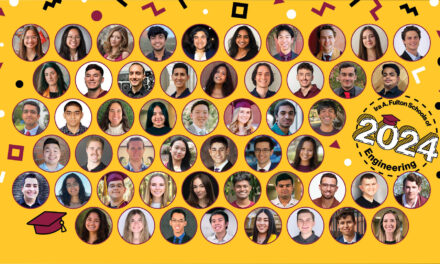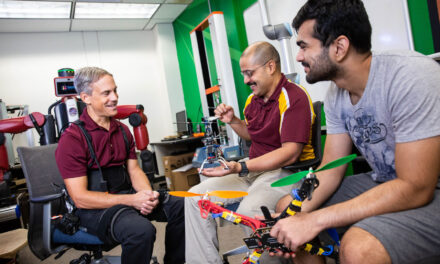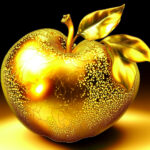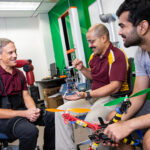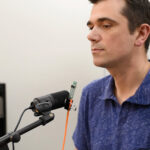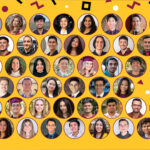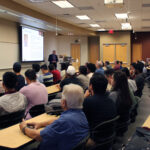
Use-inspired research: ASU students tackle real-world engineering challenges in energy, sustainability, health and more
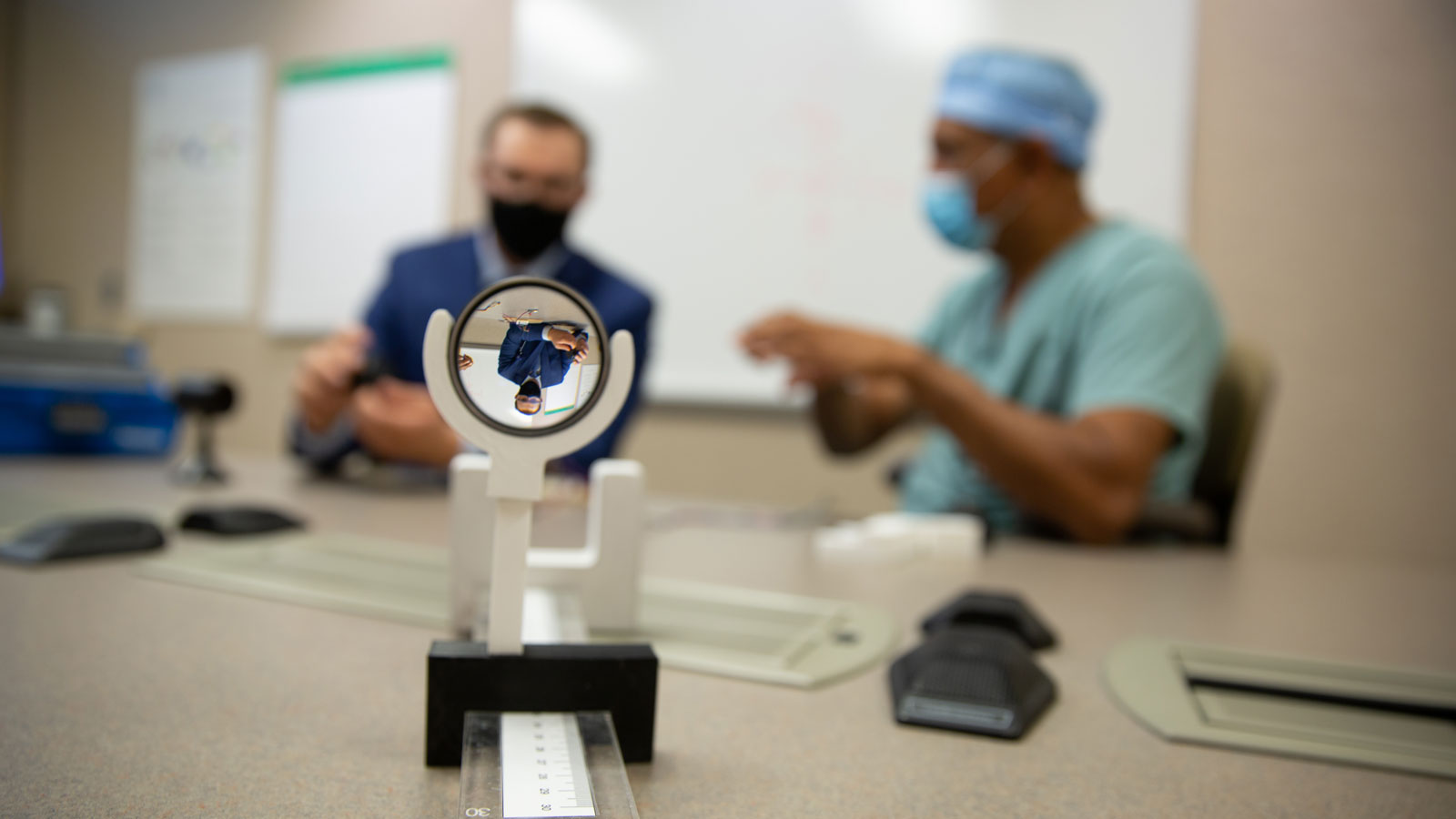
Above: Dean Spyres, an Arizona State University engineering graduate student, works with Mayo Clinic ophthalmologist Dave Patel on a project in the Master's Opportunity for Research in Engineering, or MORE, program, which will be presented at the FURI/MORE Virtual Symposium. Spyres is developing a 3D-printed modular device to turn smartphone cameras into eye imaging devices to improve access to eye care. Photographer: Erika Gronek/ASU
This article is the second in a two-part series highlighting student researchers and faculty mentors participating at the Spring 2021 FURI/MORE Virtual Symposium on April 16. Read part one. Learn more about the symposium.
Better engineering fundamentals education, a microbial tool to recover valuable products from waste and a 3D-printed modular device to make eye health care more accessible are some of the ways students in the Ira A. Fulton Schools of Engineering at Arizona State University are applying their skills through research.
Conducting research is an excellent way for students to understand how the theoretical knowledge they learn in engineering classes relates to real-world applications. Students can also make an impact in people’s lives with the innovative solutions yielded by scientific research they conduct — even before they start their careers.
There are multiple opportunities for undergraduate and graduate students in the Fulton Schools to address challenges in data science, education, energy, health, security and sustainability.
Students in the Fulton Undergraduate Research Initiative, or FURI, and the Master’s Opportunity for Research in Engineering, or MORE, programs conceptualize an idea, develop a plan and investigate their research question with a faculty mentor over the course of a semester.
Fulton Schools students in the Grand Challenges Scholars Program, or GCSP, can also conduct research for one of the competencies required by the program.
All three opportunities develop students’ skills in innovation, independent thinking and problem-solving to support their future pursuits and careers. And all are invited to participate in the FURI/MORE Symposium, an event near the end of each semester in which students present their research findings in a poster session.
Learn about four Fulton Schools students and one faculty mentor participating in the Spring 2021 FURI/MORE Virtual Symposium. Meet these students and more than 110 other student investigators at the virtual event, open to the public, on Friday, April 16, 1–3 p.m. MST.
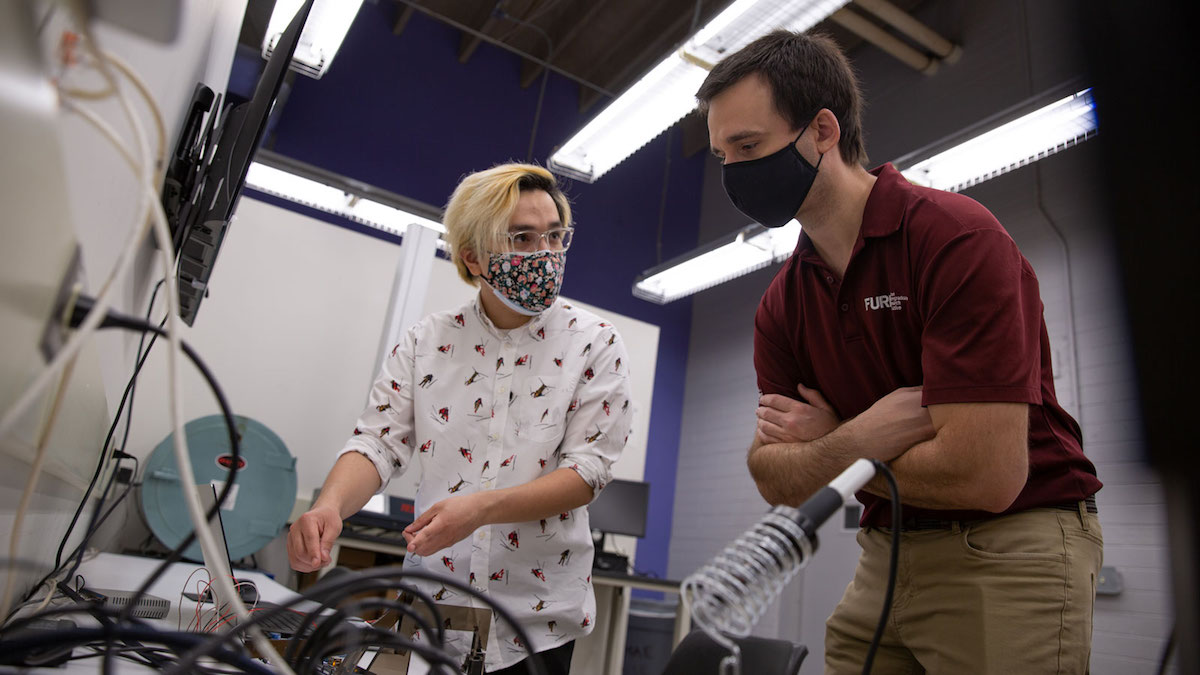
Mechanical engineering senior Jesus Pena works with his mentor Associate Professor Jay Oswald on a project exploring how to improve engineering students’ comprehension of fundamental concepts through 3D models and presentations. Photographer: Erika Gronek/ASU
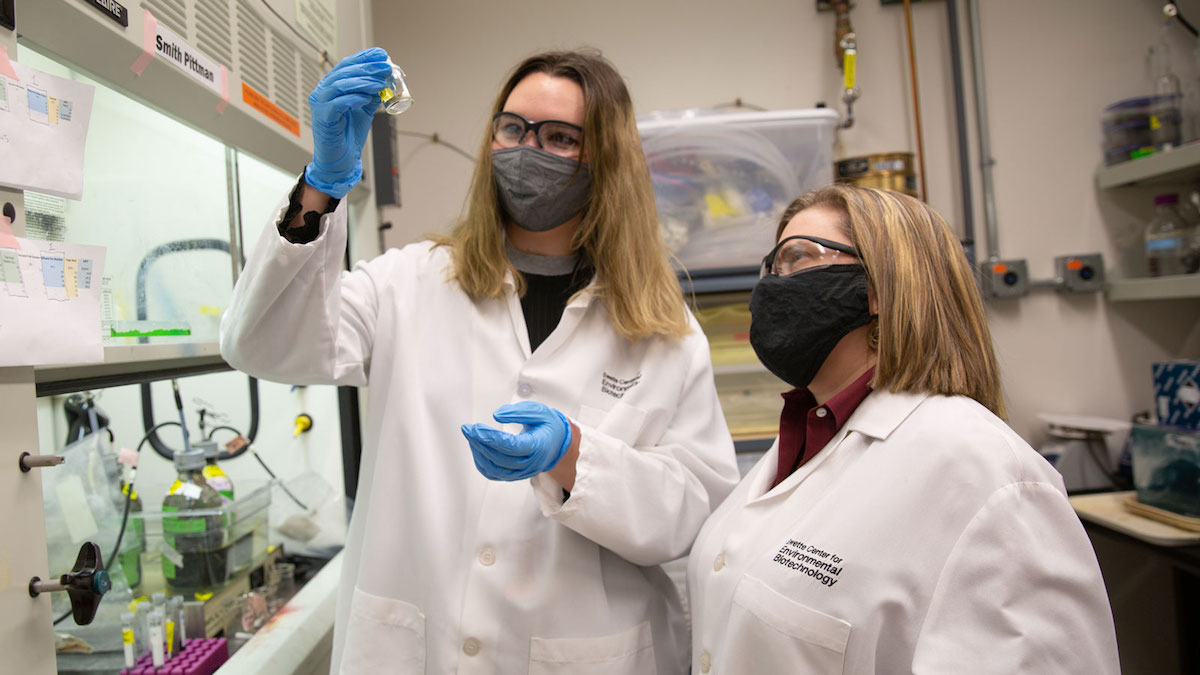
Environmental engineering major Smith Pittman (left) works with Assistant Research Scientist Michelle Young on a project to use waste biomass from industrial processes to produce valuable products. Pittman, who is conducting research as part of the Grand Challenges Scholars Program, also worked with faculty mentor Regents Professor Bruce Rittmann. Photographer: Erika Gronek/ASU
Read more about Jesus Pena
Jesus Pena is a mechanical engineering senior conducting research in the FURI program. His research with Associate Professor Jay Oswald is exploring how 3D models and presentations help engineering students gain higher comprehension of fundamental concepts.
What made you want to get involved in FURI?
I wanted to get involved in this program because it provides financial support, which is always very much appreciated, but also because it provides a great experience for any college student trying to apply what they’re learning in class to things outside of class.
I failed the first time I took statics (the study of quantifying forces between two bodies), and it was due to my lack of being able to visualize concepts based on what I was exposed to in class alone. By being a part of this project, my goal is to potentially help students who are in the same position as I once was by giving them something to see in person.
How will your engineering research project impact the world?
By showing 3D models of static principles to sophomores, it will help them develop the methodology and thinking of an engineer early on in their career. The earlier students are able to understand the fundamentals, the more time they will have to grow their understanding or interests in more complex principles. This will help teach engineers to have better fundamentals, leading to a deeper and more comprehensive understanding, which can in turn benefit society.
How do you see this experience helping with your career goals?
I think this experience will help me grow professionally because I will be able to think on my own. The classes you take set a path that everyone takes together, whereas FURI allows you to create your own path with the help of your mentor. It also gives me a great conversation starter during interviews and something that sets me apart on job applications.
What is the best advice you’ve gotten from your faculty mentor?
Do not get too caught up with certain tasks. There have been some instances when I spent more time than I should have trying to perfect something when I could have stopped the previous day and it would have been more than enough. Especially when you are dealing with a project that involves multiple disciplines working together, you need to know when to move on with that specific task to focus on others. Time is something you cannot get more of, so using the limited time you have is crucial to anything you do.
Why should other students get involved in FURI?
FURI takes the knowledge and materials from your courses and applies them to real-life applications. Having this experience before you start working in industry or continuing your education is invaluable because it keeps you ahead. Being able to apply what you learned in class to real-life projects before you graduate will help you improve your professional career.
Read more about Smith Pittman
Smith Pittman is an environmental engineering junior in the Grand Challenges Scholars Program. For the research or talent competency of the GCSP, she conducted research with Regents Professor Bruce Rittmann and Assistant Research Scientist Michelle Young to study whether cellulose predigested by microbes can recover valuable products from anaerobic digesters at wastewater facilities.
What made you want to get involved in the Grand Challenges Scholars Program?
I wanted to get involved with GCSP because as an engineer it is really important to understand the social impacts of the work you do.
Why did you choose the project you’re presenting at the FURI Symposium?
This is a relatively novel research topic, and so I think there will be potential for continued research after this project.
How will your engineering research project impact the world?
Lignocellulose is an abundant untapped resource, as it is mainly considered waste biomass from industrial processes. Finding ways to degrade it, and thereby produce valuable products, will create more sustainable processes.
In general, my mentor and I have been pleasantly surprised with the results we are getting from the experiment.
What has been your most memorable experience as a student researcher?
This is a little gross, but sometimes when feeding the reactors (which take waste materials and turn them into valuable byproducts), they will spit sludge back up. The first time this happened I was not prepared and it got everywhere. I was later able to figure out that it was due to gas buildup, and I could prevent this from happening by keeping the gas bags attached.
How do you see this experience helping with your career or advanced degree goals?
I would like to continue researching, so I am looking at graduate schools. This experience has been incredibly helpful for me because it has helped me find something that I enjoy.
What is the best advice you’ve gotten from your faculty mentor?
My mentor has really encouraged me to pursue my interests, which has helped me inside and outside the research lab.
I am very grateful for the support I receive from Dr. Rittmann, Dr. Michelle Young and GCSP.
Why should other students get involved in GCSP?
GCSP is a wonderful program for students who want to have a positive impact on the world around them, and want to know about the future of engineering. I think students should also get involved in undergraduate research because it helps you to understand the application of what you are learning in your classes.
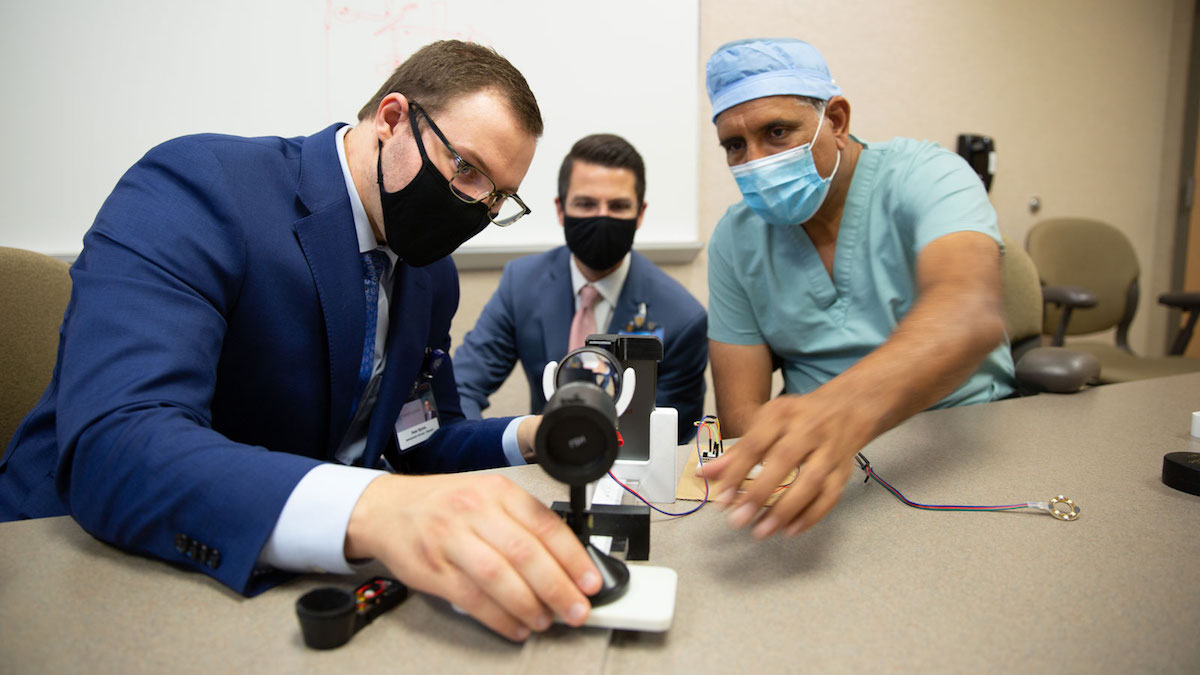
Dean Spyres (left), an engineering graduate student, conducts a demonstration with Pete Pallagi (center), manager of enterprise photography for Mayo Clinic, and Dr. Dave Patel (right), a Mayo Clinic ophthalmologist, for a research project in the MORE program. His project with Assistant Professor Troy McDaniel focuses on developing a 3D-printed modular device that turns smartphone cameras into eye imaging devices to improve access to eye care. This research project is being conducted in partnership with Mayo Clinic and sponsored by W. L. Gore & Associates.

Kelvin Tan, an electrical engineering senior, is working on a FURI research project to improve photovoltaic load management systems through the development of a new, efficient algorithm. He conducts research in Professor Meng Tao’s lab. Photographer: Erika Gronek/ASU
Read more about Dean Spyres
Dean Spyres is a graduate student in The Polytechnic School engineering program participating in the Master’s Opportunity for Research in Engineering, or MORE, program, which presents at the FURI Symposium. He is creating a 3D-printed modular lens and optical device for smartphone cameras for eye imaging. Spyres is working on this project with his mentor, Assistant Professor Troy McDaniel, in partnership with Mayo Clinic and sponsored by W. L. Gore & Associates to fund additional materials. Spyres will work on this ongoing project, which he hopes will reduce the amount of services and treatments patients need to go through and help more medical personnel to help patients without the need of specialized equipment.
What made you want to get involved in MORE?
I was interested in participating in the MORE program because I thought it would be a good opportunity to practice writing proposals, creating a poster and discussing my research. In addition, the $400 materials budget was useful for buying supplies for the project, especially during the pandemic when labs have been closed and I am partially limited to the tools I have at home.
How did you get started with this project?
This project to develop a modular optical scope device for a smartphone camera started as my senior capstone. Unfortunately, when ASU went virtual it became difficult to work on the project and the team lacked the access to resources to get it completed. I was disappointed that I was unable to see the project through to the end. But when I found out I was accepted to the master’s program, I quickly looked to find a faculty advisor and funding to continue the project for my thesis.
I was interested in this work because of the partnership with Mayo Clinic and the possibility that this modular optical device has a real application. I enjoyed working with the staff at Mayo Clinic and felt bad that we were not able to complete the project by the end of my capstone. Ultimately, I decided that I would be the one to finish the project.
Did you have a particular “aha!” moment during your project?
There wasn’t one particular “aha!” moment that I can recall. However, I do catch myself saying “oh that’s interesting” or “maybe this works.” This is primarily because I am constantly learning about the problem and creative solutions other people are proposing. This process has further intensified my interest. I use the second phase when designing parts, and I am often unsure if they will work or not.
How will your engineering research project impact the world?
The goal of this project was to design and produce a device that would increase the accessibility to diagnostic quality retinal and corneal images to the broader health care community. By enabling more personnel to document a patient’s condition while being treated, it provides the patient with a more comfortable experience and reduces the workload on physicians and specialists. This device is ideal for smaller community clinics that may not have specialized ophthalmology equipment or for medical mission trips abroad. Furthermore, with the recent increase in telemedicine popularity, this device may one day become viable for consumers to take images of their eye and send it to their physician for diagnostic purposes.
How do you see this experience helping with your career goals?
Part of the reason I decided to pursue a project with Mayo Clinic was the possibility to connect and network with some of the physicians and staff. This was important for me because I am pursuing a career in medicine with the hopes of becoming a surgeon one day. Having the possibility to talk to and learn from some of the best in the medical field was an opportunity I was unable to turn down.
What is an important skill for student researchers?
Communication is a very important skill to consistently practice and improve upon. You may have the best technical knowledge and very ambition to create or design. However, if you are unable to communicate the benefit or impact your work will have and instill that image in someone else’s mind, your work may not receive the recognition it deserves.
What are your biggest takeaways from this project and the MORE program?
This project has taught me to focus on the process, not the outcome. Because I have been working on this project for multiple semesters, I have learned to appreciate and value the process behind discovery and design. Previous projects of mine have not had the breadth of scope like this project. I have learned to celebrate the small wins and work through the difficult times when it seems like nothing is progressing.
Lastly, I would like to thank my thesis advisor, Professor Troy McDaniel, and my collaborators at Mayo Clinic, Dr. Dave Patel, Pete Pallagi and Jenny Ho, for their belief in me and support throughout the project.
Read more about Kelvin Tan
Kelvin Tan is an electrical engineering senior in the FURI program. He is developing an efficient algorithm for load management to accelerate the development of photovoltaics for the energy sector with his mentor, Professor Meng Tao.
What made you want to get involved in FURI?
My aspiration to get involved in this program was to explore and evaluate my future decisions as a graduate student. I have always wanted to make an impact in the sustainability movement and this was a great opportunity for me to see which sector I should dedicate myself to — either research or industry. The project and this program was the perfect opportunity for me to involve myself in research that quickly answered my uncertainty from before.
Why did you choose the project you’re working on?
Research on renewable systems, like solar, is a great way for me to be as impactful as possible for the clean energy movement. Designing and improving the technology to increase the incentives will drive the integration of clean energy. The project I am working on directly relates to this.
What has been your most memorable experience as a student researcher in this program?
My most memorable experience as a student researcher would have to be when my professor requested that I publish a paper for the 48th IEEE Photovoltaic Specialists Conference. Professor Meng Tao put me in an open-ended project where I could choose how much and what direction I planned to take in the project. This really pushed me to learn about the system and to make the project my own. After a lot of dedication, I felt that my work is on par with my colleagues and I am doing impactful research.
Have there been any surprises in your research?
There have been many surprises in my research. For all of the variables I analyze, I will always have an educated guess on what the results are going to be. As the project escalated and I got to look more into sophisticated processes, these results began to be unpredictable at times. They were always welcome surprises.
How will your engineering research project impact the world?
My research project will increase the opportunities in solar photovoltaic systems. The proposed system will be able to reduce the overall cost while increasing the efficiency of direct-coupled photovoltaics. Promoting renewables and energy storage is the gateway to a sustainable future. There are many roadblocks to clean technology. The goal of this project is to eliminate these obstacles and pave the way for a future society powered by clean energy.
What is the best advice you’ve gotten from your faculty mentor?
Take a step back and organize my efforts. I have a habit of rushing through all of my tasks as most academic projects have directions and end goals with just enough time in between the two. My faculty mentor made me truly analyze the basics and take a procedural approach to everything. In the end, this approach saved more time and will help improve the quality of my research findings.
Why should other students get involved in FURI?
There are so many opportunities in engineering today, and I feel as if most students will never be able to experience everything before they enter the industry. This program will help students better understand the different pathways out there and allow us to make decisions without regret. The experience and mentorship are things that cannot be taught in classes and so this is definitely an experience I would advise students to take.
FURI has been very impactful for me as a senior, but I would have liked to have experienced it earlier in my degree program. I appreciate the opportunity because I had trouble finding an activity I was passionate about until I joined the FURI program under Professor Tao.






